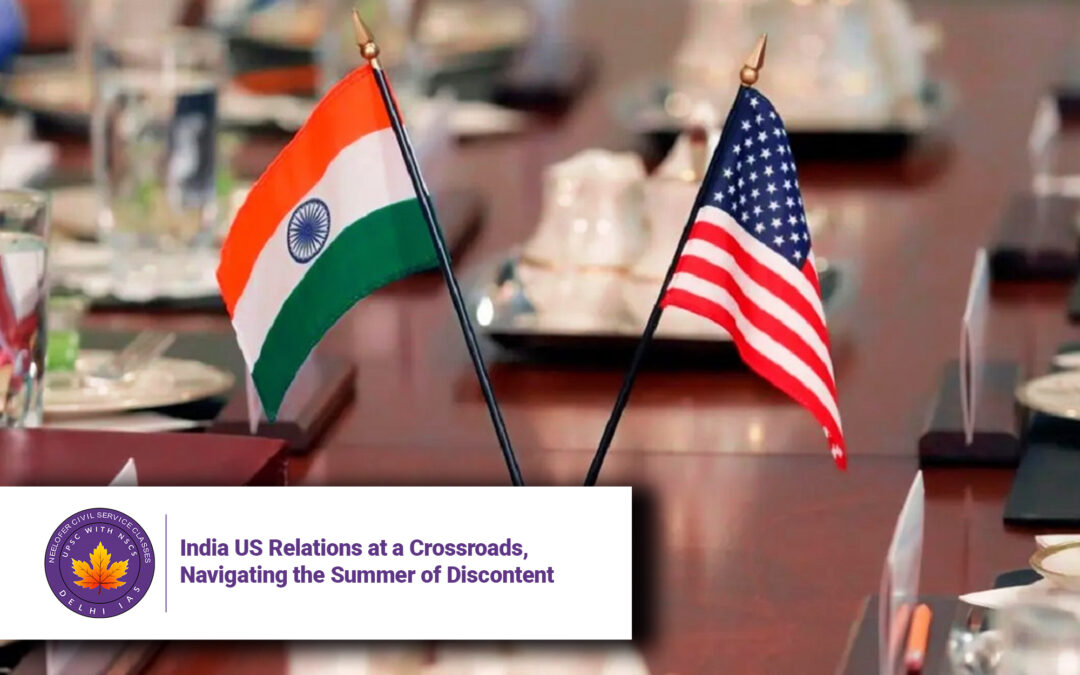India US Relations at a Crossroads, Navigating the Summer of Discontent
Introduction
The recent deterioration in India-US relations, marked by unprecedented trade tensions and diplomatic strains, represents a critical juncture in what has been one of the most consequential partnerships of the 21st century. As Ashok Malik poignantly observes, this “Summer of Discontent” threatens to undo decades of carefully cultivated strategic trust. This analysis examines:
-
Root causes of the current crisis
-
Economic and strategic implications
-
India’s potential pivot to alternative partnerships
-
Long-term consequences for Indo-Pacific geopolitics
-
5 Key Q&A on the way forward
The Unfolding Crisis: Anatomy of a Breakdown
1. Escalating Trade Tensions
| Action | US Move | Indian Response | Impact |
|---|---|---|---|
| Tariffs | 50% on $14B Indian goods | Retaliatory tariffs on 30 US products | $5B trade deficit widening |
| Tech Restrictions | H1B visa caps | Domestic IT self-reliance push | 200,000 jobs at risk |
| Agriculture | GM food demands | Stricter labeling laws | US farm exports ▼18% |
2. Diplomatic Fallout
-
Cancellation of 2+2 ministerial dialogue
-
Postponement of Quad naval exercises
-
Frosty G7 sideline interactions
Strategic Calculus: Why Now?
1. US Motivations
-
Domestic Politics: Trump’s “America First” re-election campaign
-
Strategic Anxiety: Perceived Indian tilt toward Russia/China
-
Economic Frustration: $28B trade deficit with India
2. India’s Constraints
-
Strategic Autonomy: Non-alignment 2.0 principles
-
Economic Reality: 5 million jobs tied to US trade
-
Political Imperatives: 2024 election sensitivities
Economic Fallout: Sectoral Impact Analysis
Most Vulnerable Indian Industries
-
Pharma ($7B US exports): 40% profit margin risk
-
IT Services ($194B sector): H1B restrictions hurt
-
Gems/Jewelry ($12B exports): Tariff double whammy
-
Auto Components ($8B trade): EV supply chain disruptions
Potential Winners
-
EU Trade Partners: German machinery, French defense
-
Domestic Markets: PLI scheme beneficiaries
-
Alternative Partners: UAE, Australia, ASEAN
Geopolitical Realignment: India’s Pivot Options
1. European Union
-
FTA Progress: 85% chapters finalized
-
Strategic Bonus: Access to EU tech pools
2. CPTPP Pathway
| Advantage | Challenge |
|---|---|
| Diversifies trade | Stringent labor/environment rules |
| Counters RCEP | Requires agricultural reforms |
| Tech partnerships | IPR concessions needed |
3. BRICS+ Expansion
-
New Members: UAE, Egypt, Ethiopia
-
Currency Pool: $100B contingency fund
5 Key Q&A on the Crisis
Q1: Is this worse than the 1998 nuclear sanctions?
A: More systemic—affects $160B trade (vs $3B in 1998) and involves tech decoupling risks.
Q2: Can Quad survive without strong India-US ties?
A: Likely becomes symbolic—Japan/Australia lack strategic heft to replace US leadership.
Q3: What’s the Russia factor in this crisis?
A: US anger over:
-
12% increase in India-Russia trade
-
Rupee-ruble oil deals
-
S-400 tech sharing
Q4: How credible is the EU alternative?
A: Promising but slow—EU takes 5-7 years to finalize FTAs vs US’s 2-3 year timeline.
Q5: Will this affect India’s semiconductor ambitions?
A: Yes—US controls 48% of chip IP; may restrict tech transfers to Indian fabs.
Long-Term Implications: Three Scenarios
Projected Outcomes (2030 Horizon)
| Scenario | Probability | Outcome |
|---|---|---|
| Managed Rivalry | 45% | Limited trade continues; strategic distrust |
| Cold Peace | 35% | Economic decoupling begins |
| Renewed Partnership | 20% | New administration resets ties |
Conclusion: Navigating the New Abnormal
As Malik underscores, this crisis represents more than a temporary trade dispute—it’s a fundamental reassessment of the relationship’s foundations. India’s path forward requires:
Strategic Patience: Avoid knee-jerk reactions
Economic Diversification: Accelerate EU/ASEAN ties
Technological Sovereignty: Boost domestic R&D
The “Summer of Discontent” may well be remembered as the moment India-US relations lost their innocence—but whether it becomes a turning point or mere turbulence depends on both nations’ capacity for course correction. One thing is certain: the rules of engagement have irrevocably changed.
Author
Ashok Malik
Partner, The Asia Group & Chair of India Practice







